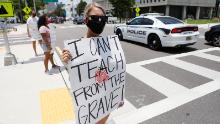US coronavirus: While nationwide surge may be slowing, officials warn of troubling Covid-19 signs across US heartland
Kansas Gov. Laura Kelly said Monday the state had reached an “unfortunate milestone” by reporting at least one case of the virus in every county. The state’s infection rate, she said, “continues an alarming trend in the wrong direction.”
To make matters worse, Kelly said, as college students return to campus, several clusters have been reported at universities. Last week, the University of Kansas reported more than 80 cases of the virus.
In Kentucky, Gov. Andy Beshear warned cases could spike again as the state reported more deaths last week than “in any other week battling the virus.”
Beshear said the state is seeing “troubling signs” and is at “the same moment that Kentucky was at in the beginning of the summer.”
“More people are trying to get out of the quarantine than the health department has recommended,” the governor said.
US Centers for Disease Control and Prevention Director Dr. Robert Redfield expressed concern last week about the heart of the country getting “stuck,” while other parts of the US, including across the South, were reporting improvements.
“That is why it’s so important for Middle America to recognize the mitigation that we talked about … it’s for Middle America too, the Nebraskas, the Oklahomas,” Redfield said. “We don’t need to have a third wave in the heartland right now.”
New daily cases over a week averaged about 43,000 as of Monday, down from a peak average of 67,317 on July 22, according to Johns Hopkins University data.
The country’s Covid-19 death rate also has dipped. The daily average across a week hovered above 1,000 for 25 straight days from late July into mid-August — but it’s been below 1,000 since Friday.
The CDC recently changed its travel guidelines online, removing direct advice to stay home for two weeks after international travel or to areas with high rates of infections.
The agency recommends that people follow state, territorial, tribal and local recommendations or requirements after travel.
Dr. Thomas Frieden, a former CDC director, argued Tuesday that people should stick to the earlier guidance.
“From an epidemiologic standpoint, if you’re going from a place with a high rate of Covid to a place with a lower rate of Covid, you need to quarantine for 14 days,” Frieden told CNN’s Wolf Blitzer. “And that is what New York state is recommending, and that’s a sensible recommendation.”
The role super spreading events play
But the warnings haven’t brought gatherings to a halt.
In Minnesota, at least 27 cases were linked to the rally, two of which were people who worked or volunteered at the event, according to Kris Ehresmann, the infectious disease division director at the state’s health department.
Last week, Maine CDC officials issued a citation to a venue that exceeded the indoor gathering limit of 50 individuals when it hosted a wedding reception earlier this month that has since been linked to a Covid-19 outbreak.
FDA commissioner acknowledges error in his claims about convalescent plasma data
The US Food and Drug Administration’s commissioner acknowledged Monday that he mischaracterized data about the potential benefits of convalescent plasma in treating Covid-19.
While explaining that decision, Commissioner Dr. Stephen Hahn said Sunday that data from a Mayo Clinic study showed use of plasma reduced the risk of death by 35%, and said that meant if 100 people got coronavirus, 35 would survive because of the treatment.
That’s not what the study showed. This study, released August 12 in a preprint, meaning it had not yet been peer-reviewed, showed that those treated with plasma containing the highest levels of antibodies had a 35% lower risk of dying within a week compared to those treated with less-rich plasma.
The study did not show the use of plasma reduced the overall death rate by 35%. Hahn admitted Monday he had been inaccurate.
Iowa officials confirm first child death
Iowa’s health department confirmed the state’s first death of a child from Covid-19 complications in a news release this week. The child was under the age of 5 and died in June, according to the release. The child also had “significant underlying health conditions,” health officials said.
The children’s deaths come as many schools across the country have welcomed students back to class, while others have opted to begin the year remotely.
The guidelines say in general, children are less likely to have severe symptoms than adults. The risk of teachers, school administrators and other staff will, however, “mirror that of other adults in the community” if they get sick, the guidelines said.
Some colleges have also opted to go online while others, who welcomed students back to campus, have — in some cases — reported hundreds of Covid-19 infections.
CNN’s Jennifer Henderson, Jason Hanna, Maggie Fox, Jason Hoffman, Gisela Crespo, Laura Ly and Pierre Meilhan contributed to this report.









